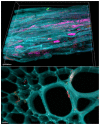Unraveling the plant microbiome: looking back and future perspectives
- PMID: 24926286
- PMCID: PMC4045152
- DOI: 10.3389/fmicb.2014.00148
Unraveling the plant microbiome: looking back and future perspectives
Abstract
Most eukaryotes develop close interactions with microorganisms that are essential for their performance and survival. Thus, eukaryotes and prokaryotes in nature can be considered as meta-organisms or holobionts. Consequently, microorganisms that colonize different plant compartments contain the plant's second genome. In this respect, many studies in the last decades have shown that plant-microbe interactions are not only crucial for better understanding plant growth and health, but also for sustainable crop production in a changing world. This mini-review acting as editorial presents retrospectives and future perspectives for plant microbiome studies as well as information gaps in this emerging research field. In addition, the contribution of this research topic to the solution of various issues is discussed.
Keywords: biocontrol; meta-organisms; plant growth promotion; plant microbiome; plant-microbe interaction; stress protection.
Figures

References
-
- Bacon C. W., White J. F. (2000). Microbial Endophytes. New York: Marcel Dekker Inc
Publication types
Grants and funding
LinkOut - more resources
Full Text Sources
Other Literature Sources

